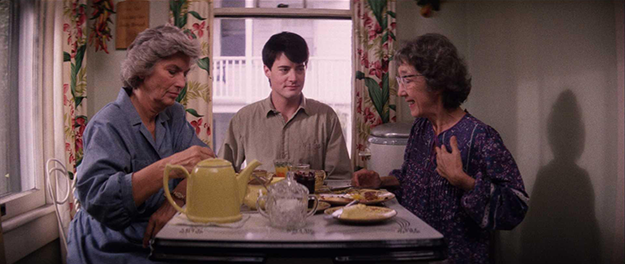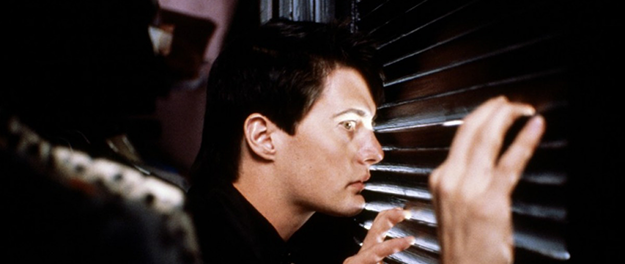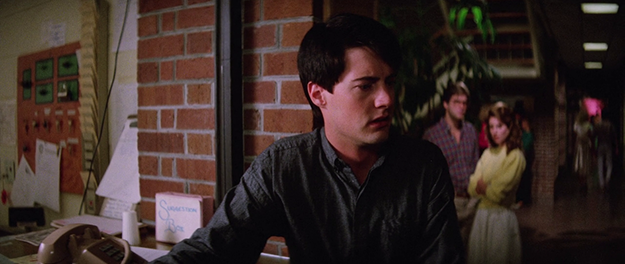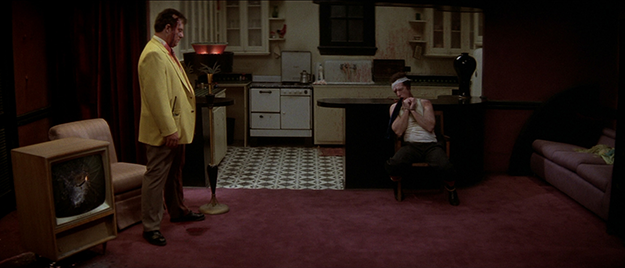Blue Velvet There are few scenarios so well suited to the constraints of mainstream film as the homecoming. It’s a universal experience that perfectly follows the three-act structure, as the protagonist is called back home and there has life-altering experiences that either explode or realign closely held values. But what Syd Field won’t tell you is that the manner of oak which grows from the acorn of this premise—and what sort of discovery the character makes—can vary wildly among extremes depending on the storyteller. You can get something like This Is Where I Leave You, Shawn Levy’s cloying, risible drama centered on a family sitting shiva for their patriarch (and being as annoying and self-absorbed as ever), or one of those Christmas calendar-fillers (The Night Before, Love the Coopers) in which a dysfunctional family snipes at each other for 90 dramedic minutes. Or you just might get a film like Blue Velvet, which charts a young man’s journey into a dangerous, adult world that he was previously unaware existed in his hometown. Jeffrey’s level of familiarity with darkness in all senses is part of the film’s narrative intrigue and his emotional development. Just as there are beetles gnawing away under the dark earth of a freshly cut suburban lawn, so is our fresh-faced protagonist capable of shadowy pursuits such as rough sex with someone else’s wife and blowing a drug dealer’s brains out. (It also underpins the emotional struggle at the heart of the film: at one point, Jeffrey breaks down sobbing to his love interest Sandy, saying that he can’t understand how a bad person like Frank Booth could exist.) Jeffrey, first introduced strolling through a field at midday on his way to visit his impossibly ill father in the hospital, becomes more and more nocturnal as he continues his investigations of Frank and Dorothy. Scenes are lit and staged to depict him emerging from and disappearing into total darkness; at the end, he’s glimpsed sunbathing before having lunch with Sandy and his family. (The finale’s other pointed detail is a mechanical robin holding a large, writhing bug in its beak, a restoration of order foretold in Sandy’s dream—but its falseness can be viewed as making this restoration ironic, or not real.)
Blue Velvet Blue Velvet poses a powerful counternarrative to the usual homecomings that has hardly been rivaled, but in an earlier conception of the film, Jeffrey was a far different character. As the deleted scenes on the 25th-anniversary Blu-ray demonstrate, David Lynch had originally intended for Jeffrey’s abrupt return from college to be more punishing and permanent. Before the descent into darkness that we know in the current version, he is infuriated by his homecoming, which strains his interactions with his single-minded and insensitive mother and aunt. Throughout her scenes (in an expanded, gadfly role for Priscilla Pointer), Mom hardly goes five minutes without reminding him that they can’t afford to send him back to school. His troubles with women don’t stop there: Jeffrey’s college girlfriend, Louise, whom he claims to love but almost constantly bickers with, is indifferent to his departure and tells him over the phone that she’s going to some dance with another guy, effectively ending their relationship. In such scenes, Jeffrey is less a blithe innocent and more akin to another Lynch creation: the title canine of his comic strip The Angriest Dog in the World (83-92), which depicts a dog tied to a chain in a backyard that growls while overhearing snippets of inane conversation (or bad puns) from inside its house. As the first panel explains: “The dog who is so angry he cannot move. He cannot eat. He cannot sleep. He can just barely growl . . . Bound so tightly with tension and anger, he approaches the state of rigor mortis.” It’s difficult to think of a sharper metaphor for dealing with situations where you feel like you can’t speak your mind, and have no option to make a polite exit. This particular variety of simmering resentment is an undercurrent in much of Lynch’s work, from the frustrated, primitive forms in his paintings to the brusque FBI Agent Albert Rosenfeld, or more explicitly manifested in the Ids that inhabit Dumbland. And, as Lynch himself has explained, his own struggles with anger are what drove his initial interest in practicing Transcendental Meditation. (Isabella Rosellini once described him as the happiest person she’d ever known, an assertion that’s interesting to bear in mind while watching the documentary Lynch (one).) But the biggest revelation of the Blu-ray’s deleted scenes—echoing the differences between Agent Dale Cooper in the pilot of Twin Peaks (who gleefully inspects Laura Palmer’s corpse) and the squeaky-clean Cooper of the rest of the series—is a scene set at a kegger at Jeffrey’s college before he has returned home. In a dorm room basement, Jeffrey secretly watches a couple furiously making out on a barren mattress, and waits an uncomfortably long time to intervene after the woman makes it clear she doesn’t want to have sex. It’s a damning (and uncomfortable) moment, but there are several others in the Blu-ray’s deleted scenes that also complicate Jeffrey’s backstory going into the story. At different moments in these excised scenes, Jeffrey surreptitiously peers through venetian blinds, which mirror the doors of Dorothy’s closet—making clear he’s predisposed to peeping. By making these tendencies explicitly present before Jeffrey crosses paths with Frank and the wrong side of Lumberton’s tracks, his character seems more duplicitous than curious about or tortured by his sexual urges. This Jeffrey is someone who’s been willfully misrepresenting himself to everyone—meaning that there’d be no homecoming transformation.
Blue Velvet (deleted scene) Whether or not Blue Velvet would have achieved cult status were these scenes included, it is safe to say that it would’ve been very different tonally and spurred different interpretations of the film. (Given that these scenes effectively nullify the character’s affable nature, the character also comes off a little bit smarter than he does in the final version.) Yet the mastery of Lynch’s probing, drifting camera, Alan Splet’s frequently terrifying sound design, and the wide range of colors and moods in Frederick Elmes’s photography help elevate the film’s Freudian-tinged, quasi-existential crisis, which some Eagle Scout might have on an unexpected semi-hallucinatory trip home, into something truly wonderful. Blue Velvet is a film predicated on precise details, frequently flipping the accepted understanding of what should or should not be emphasized in a narrative film. These reversals of foreground and background are evident from the opening sequence, which lingers on tulips against a white picket fence and a slowed-down shot of a bright red fire truck (complete with smiling, waving firemen and Dalmatian). These are the only bits of Americana that are foregrounded in such a way and aren’t shunted into a longer montage of small-town signifiers; instead, each is given time to breathe and become magnified. This collage of pleasantness and purity is contrasted with the details Lynch through which composes Lumberton’s seedy underworld. Distributed across the frame, these arranged scenes suggest still lives by way of Francis Bacon: for example, the party at Ben’s apartment (which, prior to Frank’s arrival, seems to be almost exclusively attended by heavyset, middle-aged women) and the penultimate sequence at Dorothy’s apartment during the police raid. Dorothy’s apartment (which Michel Chion once perfectly described as being the color of a bruise) is littered with the remnants of some horrific violence: the man in yellow, a dirty police officer working with Frank, stands upright next to an art deco lamp with a bit of brain poking out of his skull, barely conscious; Dorothy’s husband is dead, bound to a chair wearing only boxers and undershirt, a bit of her robe stuffed in his mouth, face frozen in a wince. The rest of the apartment, with a large, spiky potted plant near the corner and matching grey couches, also projects a sense of foreboding—all without ever using close-ups on all of the many things that are perverse, disturbing, or out of place. The closest the camera gets to either the man in yellow or Dorothy’s husband are medium shots, and these are done in service of following Jeffrey’s or Frank’s movements through the apartment around them. Stripped of their humanity, they have been reduced to objects that exist in a visual field.
Blue Velvet In other words, each of these frames is composed the way memories are formed, a network of associations flowing out of one or two details. Lynch’s use of space and mise en scene reflects not only his training as a painter but also his own approach to storytelling: specific places or feelings are evoked, but they retain a degree of falseness by the way that they’re mediated. (I’m thinking again of the robin at the film’s conclusion, which is clearly fake; the magical realist ending of Wild at Heart functions in a similar, more extreme way.) This interplay of specificity and artifice works in tandem with the way in which he envisions characters, which are very often not truly human beings, but a set of personality quirks (an angry woman with, say, an eye patch) or a narrative arc (a woman in trouble, a very bad man) personified. His stories have little to say about our world in practical terms, other than that there is a lot of violence and evil out there, very often in the service of nothing but ego. They’re Manichean and aspirational tales, just as Sandy’s dream conflates the returning of birds with the return of light and goodness. (The endings of Twin Peaks: Fire Walk with Me and Inland Empire have nearly identical, angelic visions of a return to peace, wherein a “woman in trouble” levitates in bliss above the sick world that’s done her wrong.) The fantastical and strange vision of going home that Blue Velvet offers, refracted and distorted through tactile details, is one that should be seen on a big screen, as many times as possible. The 30th-anniversary restoration of Blue Velvet screens March 25 to 31 at Film Forum.



